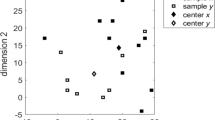Abstract
A class of multivariate nonparametric tests for spatial dependence, Multivariate Sequential Permutation Analyses (MSPA), is developed and applied to the analysis of spatial data. These tests allow the significance level (P value) of the spatial correlation to be computed for each lag class. MSPA is shown to be related to the variogram and other measures of spatial correlation. The interrelationships of these measures of spatial dependence are discussed and the measures are applied to synthetic and real data. The resulting plot of significance level vs. lag spacing, or P-gram, provides insight into the modeling of the semivariogram and the semimADogram. Although the test clearly rejects some models of correlation, the chief value of the test is to quantify the strength of spatial correlation, and to provide evidence that spatial correlation exists
Similar content being viewed by others
REFERENCES
Ali, M. M., 1984, An approximation to the Null distribution and power of the Durbin-Watson statistic: Biometrika, v. 71,no. 2, p. 253–261.
Baczkowski, A. J., and Mardia, K. V., 1987, Approximate lognormality of the sample semi-variogram under a Gaussian process: Commun. Statist. Simul., v. 16,no. 2, p. 571–585.
Berry, K. J., and Mielke, P. W., Jr., 1983, Computation of finite population parameters and approximate probability values for multi-response permutation procedures (MRPP): Commun. Statist. Simul., v. 12,no. 1, p. 83–107.
Cressie, N. A. C., 1991, Statistics for spatial data: John Wiley & Sons, New York, 900 p.
Davis, B. M., 1987, Uses and abuses of cross-validation in geostatistics: Math. Geology, v. 19,no. 3, p. 241–248.
Davis, B. M., and Borgman, L. E., 1982, A note on the asymptotic distribution of the sample variogram: Math. Geology, v. 14,no. 2, p. 189–193.
Dowd, P. A., 1984, The variogram and kriging: robust and resistant estimators, in Verly, G., and others, eds., Geostatistics for natural resources characterization: Reidel Publ., Dordrecht, v. 1, p. 91–106.
Durbin, J., and Watson, G. S., 1950, Testing for serial correlation in least squares regression I: Biometrika, v. 37,no. 3, p. 409–428.
Gotway, C. A., and Hergert, G. W., in press, Incorporating spatial trends and anisotropy in geostatistical mapping of soil properties: Am. Jour. Soil Sci.
Huber, P. J., 1972, Robust statistics: a review: Ann. Math. Stat., v. 43,no. 4, p. 1041–1067.
Issaks, E. H., and Srivastava, R. M., 1989, Applied geostatistics: Oxford Univ. Press, New York, 561 p.
Journel, A. G., 1988, New distance measures: the route toward truly non-gaussian geostatistics: Math. Geology, v. 20,no. 4, p. 459–475.
Mielke, P. W., 1991, The application of multivariate permutation methods based on distance functions in the earth sciences: Earth Sci. Rev. v. 31,no. 1, p. 55–71.
Mielke, P. W., Jr., Berry, K. J., and Johnson, E. S., 1976, Multi-response permutation procedures for a priori classifications: Commun. Statist. Theory Methods, v. 5, p. 1409–1424.
Orlowski, L. A., Grundy, W. D., Mielke, P. W., Jr., and Schumm, S. A. 1993, Geological applications of multi-response permutation procedures: Math. Geology, v. 25,no. 4, p. 483–500.
Shafer, J. M., and Varljen, M. D., 1990, Approximation of confidence limits on sample semivariograms from single realizations of spatially correlated random fields: Water Resources Res., v. 26,no. 8, p. 1787–1802.
Solow, A. R., 1990, Geostatistical cross-validation: A cautionary note: Math. Geology, v. 22,no. 6, p. 637–639.
Stein, M. L., and Handcock, M. S. 1989, Some asymptotic properties of kriging when the covariance function is misspecified: Math. Geology, v. 21,no. 2, p. 171–190.
Switzer, P., 1984, Inference for spatial autocorrelation functions, in Verly, G., and others, eds., Geostatistics for natural resources characterization: Reidel Publ., Dordrecht, pt. 1, p. 127–140.
Vinod, H. D., 1973, Generalization of the Durbin-Watson statistic for higher order autoregressive processes: Commun. Statistics, v. 2,no. 2, p. 115–144.
Zimmerman, D. A., and Wilson, J. L., 1990, Description of and user's manual for TUBA: a computer code for generating two-dimensional random fields via the turning bands method: SeaSoft, Albuquerque, 116 p.
Author information
Authors and Affiliations
Rights and permissions
About this article
Cite this article
Walker, D.D., Loftis, J.C. & Mielke, Jr., P.W. Permutation Methods for Determining the Significance of Spatial Dependence. Mathematical Geology 29, 1011–1024 (1997). https://doi.org/10.1023/A:1022309619605
Issue Date:
DOI: https://doi.org/10.1023/A:1022309619605




